Your dog’s split nail can be quite painful for him or her (and a bloody mess too). Learn how to provide first aid for a split nail from integrative veterinarian Dr. Julie Buzby. Plus, discover nine reasons for a split nail and the most common treatments.
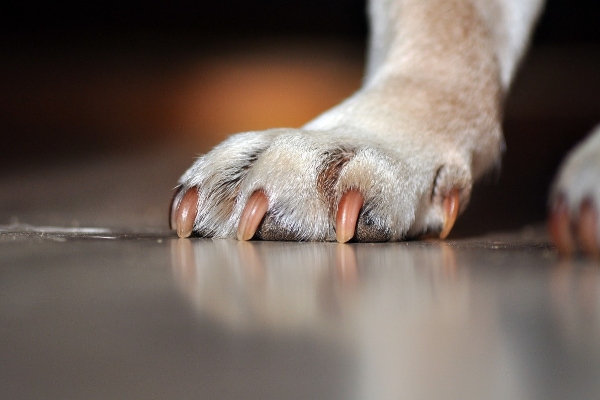
A dog’s toenails are important to him or her. This statement becomes even more apparent when your dog damages a toenail and is suddenly in extreme pain. Your dog’s split nail can quickly cause his or her day (and your day too) to go from happy to horrible.
So let’s take a look at how you can provide first aid if your dog does split a nail, and explore nine reasons the nail tends to split in the first place.
- How do you know if your dog splits a nail?
- What should you do if your dog splits a nail?
- How will your vet fix a split nail on a dog?
- Are there long-term issues from split nails?
- How do you keep your dog's nail from splitting?
- Dog nail anatomy
- 9 Reasons why your dog's nails are splitting
- Evaluate and trim your dog's nails regularly
- Has your dog ever split a nail?
How do you know if your dog splits a nail?
The first step in first aid is recognizing the problem, so we’ll start by reviewing the symptoms of a split nail.
For most toenail injury cases, pet owners might see obvious signs like a nail that is split and bleeding. However, for other pups, the signs of a toenail injury may be a little more subtle. You may notice:
- Paw pain (holding the paw up or licking it excessively)
- A bleeding paw (or spots of blood wherever the dog steps)
- Swelling around the toe or paw
- Discharge around the base of the claw
Keep in mind that while bleeding around the paws can come from a split nail, it may also indicate a paw pad injury or that the dog has ripped a nail off. Plus, foreign bodies such as foxtails in dogs may also cause paw swelling and limping. Thus, if you notice any of the above symptoms, it is worth taking a closer look at your pup’s foot if he or she will tolerate it.

Tips for evaluating your dog’s paw
Remain calm and consider keeping some treats handy while you try to assess your dog’s paw. This can keep your doggie calm, which helps keep his or her blood pressure low to minimize any bleeding.
Many dogs can be distracted with snacks such as xylitol-free peanut butter or spreadable cheese. However, remember that even the sweetest dog may bite when in pain. Please don’t do anything that could put you in danger. If your dog is wary or painful, either see if you can safely muzzle your dog to get a better look at the paw, or head to the veterinary clinic.
If you are able to touch your dog’s paw, you can proceed with the evaluation. Gently brush away dirt or try to clean the paw with cool water and mild soap. Then look at the nail base, nails themselves, paw pads, area between the toes, and the top of the foot.
What should you do if your dog splits a nail?
If the nail is split vertically or horizontally, chipped, missing, dangling, or otherwise damaged, follow these first aid steps until you can get your dog to the vet.
1. Apply pressure and/or a styptic product to stop the bleeding
In many cases, there is active bleeding from the nail. You can use a clean cloth, cotton ball, or piece of sterile gauze to stop your dog’s nail from bleeding. Apply gentle pressure to the nail for about five to ten minutes.
If the bleeding hasn’t stopped by that time, you may need to use a styptic pencil or styptic powder (e.g., Kwik-Stop). Or you can try baking soda, corn starch, or flour if you don’t have styptic powder in your dog first aid kit. These substances have a similar consistency to styptic powder so they should work too. Then apply pressure for another five minutes.
In a pinch, you can also stick the bleeding claw into a solid bar of soap. However, is not recommended to use super glue for a split nail because this can cause more stinging and discomfort. It may also trap infection if present.
2. Evaluate the nail to see if you should remove the damaged part
If there is a loosely attached piece of claw, you may be able to pull it away without incident. But keep in mind that it should be very loose—we’re talking hanging on by a sliver.
If this is not an option, sometimes you can trim off some of the injured nail. This tends to work best if the split is mostly confined to the non-sensitive part of the nail.
Keep in mind that if your dog is painful, or the nail is still bleeding, it is best to proceed to your veterinarian for further care. When in doubt, do not attempt to trim or remove the injured nail yourself.
3. Apply a bandage to the paw
To protect the injured nail (or exposed tissue if the nail ripped off), it can be helpful to apply a bandage. Use clean bandaging materials and check out my article on how to wrap a dog’s paw for instructions. (Alternatively, if you don’t have bandaging material, wrapping your dog’s paw in a clean towel can work in a pinch.)
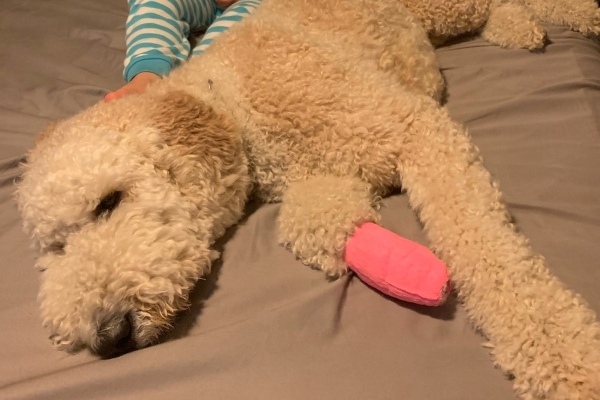
Keep in mind that a bandage that is too tight can restrict your dog’s circulation. This can become dangerous. To check the tightness of your bandage, try to slip one or two fingers in the top. If you can’t get your fingers in, the bandage is probably too tight. Also watch for swelling, coolness, or discoloration of the foot. These signs tend to occur with a too-tight bandage.
4. Contact your veterinarian
Whenever your dog has a toenail injury that is painful, bleeding, or exposes the inner tissue of the nail (i.e. the quick) or the nail bed, it is a good idea to check in with your veterinarian. If the nail damage is minor, he or she may recommend monitoring your dog.
But with more significant splits, pain, or bleeding, your vet will probably want to see your dog. Uncontrolled pain or bleeding usually necessitates an emergency vet visit . But managed pain or bleeding may be fine for a same-day or next-day appointment with your regular vet.
How will your vet fix a split nail on a dog?
The veterinarian will start out by evaluating the split in the nail. Plus, he or she may want to investigate any potential underlying causes (which we will discuss in a bit). Then he or she will make a plan for treating your dog’s split nail. The exact treatment will depend on the extent of the damage and the underlying reason for the split.
Trimming or removing the nail
If a toenail has been injured but there isn’t any splitting or bleeding, your pup may be just fine with monitoring alone. Or if the split results in a small, loosely attached piece of claw, your vet can simply trim the nail to resolve the problem.
However, dog nails that split lengthwise or vertically and expose the quick (i.e. inner nerves and blood vessels) are trickier to fix. The vet must remove the broken nail in order to relieve discomfort and provide a good foundation for regrowth. Often, these nails are solidly attached and can be immensely painful to remove.
To help with claw removal, your vet may recommend sedating your canine companion and numbing the area. Then, he or she will remove the nail or clip it just beyond the split. The vet will take great care not to damage the exposed quick if possible. Since the quick contains blood vessels, it can bleed profusely.
If there is bleeding, which is sometimes unavoidable, the vet may use styptic powder to stop it. Or he or she may wrap the paw in a bandage. Sometimes the vet may recommend keeping the bandage on for a day or two to help promote clot formation and prevent infection.
Pain medication, antibiotics, and E-collars
Your vet may also recommend using an Elizabethan collar (E-collar), a comfy cone, or an inflatable collar to keep your dog from licking the damaged nail. Since broken nails can be extremely painful, the vet will often prescribe several days of pain medications for your dog too.
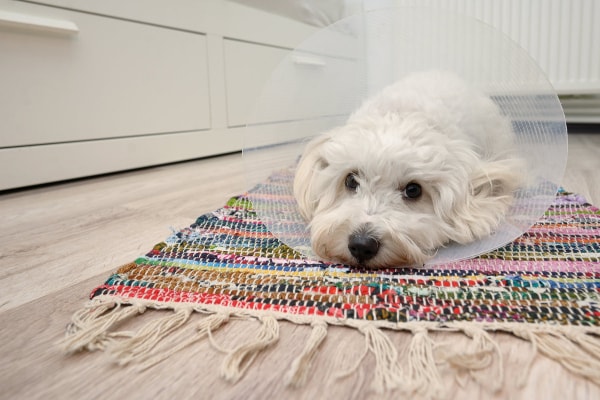
Sometimes, but not always, he or she may recommend antibiotics. Typically, the vet will reserve antibiotics (oral or topical) for situations where there is a concern for active infection (e.g., if the quick was exposed for several days or the vet noticed pus coming from the area).
The veterinarian will also discuss the necessary at-home treatments, monitoring, and follow-up visits. It is important to follow your vet’s instructions and contact him or her if you are worried about how your dog’s nail is healing.
Are there long-term issues from split nails?
Thankfully, for most dogs with split open nails, there are no long-term effects. Many injured nails tend to regrow and will look identical to the nail that came before it, even if the nail split all the way up.
However, dogs with concurrent health issues may have delayed nail growth. Or the claw may grow back in an abnormal way (e.g., bigger or smaller than previously, growing in a different direction, or with different coloring).
If you have any concerns about how your dog’s nail looks, please contact your vet. While most of the time the changes in nail growth are harmless, cancer can sometimes cause an abnormal-looking nail.
How do you keep your dog’s nail from splitting?
While it is good news that the vast majority of spilt nails are no big deal long-term, they are painful and stressful for your dog. So understandably, preventing split nails is ideal.
Learning to trim your dog’s nails
The biggest piece of advice I can give dog parents who want to keep their dog from splitting his or her nails is to perform regular nail trims. Keeping your dog’s nails short makes it less likely they will snag on anything and split.
I know that dog nail trimming can be intimidating for some people (and dogs). It doesn’t have to be, though. You can learn how to perform a successful dog nail trim without blood, sweat, or tears! Your veterinary team would be happy to demonstrate nail trimming for you.
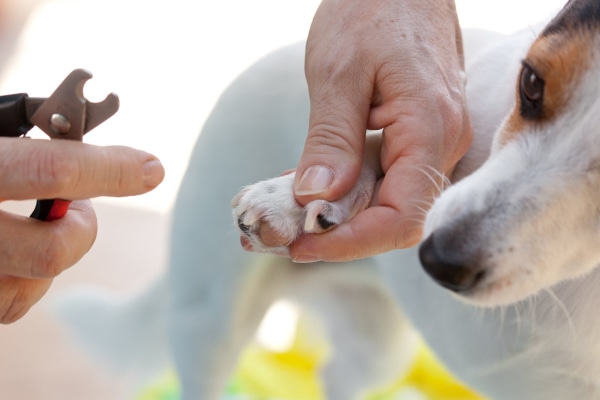
And, because nail trimming is one of the things I’m passionate about, I also developed a dog nail trimming master course. It walks you through everything you need to know about nail trimming, including how to choose the best dog nail clippers. Since dull cutters can increase the chances of a nail splitting during trimming, it is important to find sharp nail trimmers that work well.
As a side note, I also recognize that trimming your dog’s nails at home isn’t the right choice for every person or dog. And that is ok too! There is no shame in deciding that you would rather have the veterinary team or groomer trim your dog’s nails. At the end of the day, the important thing is that someone keeps your dog’s nails short.
Nail health supplements
There aren’t any specific pet health supplements available to guarantee the healthiest of toenails. But omega-3 fatty acids for dogs and/or vitamin E may help promote healthy, strong claws. However, since these substances are already found in most commercial diets, talk to your vet before starting any additional supplements.
Incidentally, although I recommend it primarily for arthritis, pain, and vitality, Dr. Buzby’s Encore Mobility, which is powered by New Zealand Deer Velvet, has been reported by many of my customers to promote dog nail growth. Because it has no side effects, I would recommend it for a canine patient who needs help growing healthier, stronger nails.
Managing the cause of the split nails
Finally, sometimes there is an underlying condition that causes your dog to be more prone to splitting a nail (or nails). Your veterinarian can work with you to develop a plan to manage those conditions. And, hopefully, that will improve your dog’s nail health and decrease nail splits or breaks.
Dog nail anatomy
Before we get into the causes of split nails, I do want to provide you with some background information about your dog’s nails. Knowing a bit of dog toenail anatomy can help you make sense of split nails.
Your dog’s claws consist of the same solid material (i.e. keratin) that makes up human nails. But rather than being flat, thin, and slightly curvilinear, dogs’ nails are conical in shape. Hidden inside the hard nail is a tubular, pink, soft tissue structure called the quick.
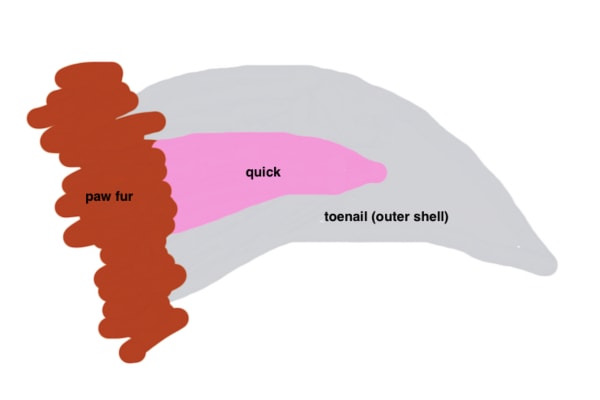
The quick
A bundle of nerves and blood vessels make up the quick. This is why accidentally cutting the quick during a nail trim can cause bleeding and be painful for your pup. And it also explains why split nails are so excruciating for your dog.
The quick is normally fairly resistant to infection because the hard part of the claw encloses it. But a split or broken nail can expose the quick to the outside environment. This increases the risk of osteomyelitis (i.e. bone infection) because the quick is connected to one of the bones in your dog’s toe.
Nail growth
Dog claws are continuously growing—about one to two millimeters per week for the average canine. Since the main function of your dog’s nails is to provide traction or grip while walking and running, the nail itself may wear down faster in active dogs or those who regularly walk or run on concrete surfaces.
Conversely, dogs who are inactive or mostly walk on soft surfaces may naturally have longer nails. As we will soon discuss, long nails tend to increase the chances a nail will split.
The exception to this would be your dog’s dewclaws, which (if present) do not contact the ground. Therefore, they don’t naturally get filed down. In this case, the fact that they are located higher up on a dog’s leg (and are sometimes floppy) may make dogs more likely to snag them, creating a dewclaw split.
9 Reasons why your dog’s nails are splitting
1. Trauma to the nail
The majority of the time, dog nails break because they aren’t being trimmed regularly. Long nails are much more prone to injury—there’s simply more claw available to snag on fabric, carpeting, grass roots, and other items.
However, even if you keep your dog’s nails short, it is still possible for him or her to split a toenail. For example, when dogs jump down onto a hard surface from an elevated location, their body weight can occasionally create enough pressure to break a claw. This is especially a problem for overweight dogs.
Additionally, anxious or nervous dogs may resort to clawing at their kennel doors or the walls in the house when confined. This can result in cracked or bleeding toenails. Sometimes there will be a complete split, but other times the dog’s nail may only split on one side.
While nail trauma accounts for most of the splits, sometimes there is more at play. To understand why your dog has a split nail (or keeps splitting nails), your vet may also consider these additional causes.
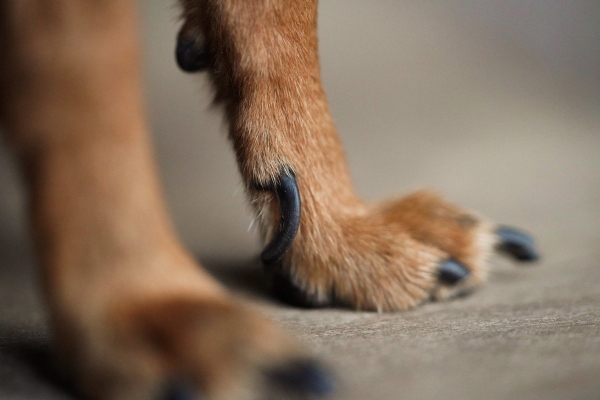
2. Infection
Another potential cause for split nails is an infection in the nail bed—the small fold of tissue that covers the base of the nail. The nail bed is a great place for bacteria or yeast to hide out. And since the folded nature of the tissue also traps moisture, this can create a prime situation for nail bed infections (i.e. paronychia).
Bacteria and yeast can cause primary nail bed infections. Or they can accumulate secondary to any conditions that create inflammation of the skin. For example, allergies are one of the most common causes of secondary bacterial skin infections in dogs (i.e. pyoderma in dogs) or dog paw yeast infections. And allergies can cause secondary nail bed infections too.
These yeast or bacterial infections can compromise the nail bed. This increases the risk of a dog’s nails splitting and breaking. Plus, paronychia may cause redness of the nail bed and a brown coloration at the base of the nail bed.
3. Parasites
Similar to how bacterial and fungal infections can affect the health of a dog’s nail bed, certain parasites can also increase the risk of damaged nails.
For example, fleas can cause skin inflammation, particularly if the affected dog has an allergy to flea saliva (i.e. flea allergy dermatitis or FAD). The inflammation from fleas or FAD can contribute to poor claw health. Plus, frequent scratching may make the dog even more likely to suffer a torn nail.
Additionally, demodectic mange (caused by the Demodex mite) can also lead to brittle nails. These mites normally live in a dog’s skin. But they can start causing hair loss, red skin, and inflammation if they begin to multiply out of control. Sometimes dogs with demodectic mange will have canine pododermatitis, which is inflammation centered around the feet. These dogs may have multiple toenails that are splitting.
4. Nutrition
For healthy nails, our furry friends rely on the same nutrients that humans do (e.g., omega-3 fatty acids, amino acids to build keratin, etc.). Thankfully, most commercial dog diets provide sufficient amounts of these nutrients. But failure to feed your dog a complete and balanced diet can result in poor skin health and nails that can split in half.
5. Inherited disorders
Certain breeds like the Siberian Husky and the Alaskan Malamute can have a heritable condition affecting zinc metabolism (i.e. zinc responsive dermatosis). Dogs with the condition often have gastrointestinal symptoms, cracked paw pads, and split nails.
Another heritable disorder, symmetric lupoid onychodystrophy (SLO), can cause sloughing of the nail. In other words, the entire claw can simply slip away from the quick under mild pressure. This may happen to several nails on the same foot and can affect multiple feet. Interestingly, the split nails often don’t bleed much, if at all.
SLO tends to affect Gordon Setters and German Shepherd dogs. But other dog breeds like Labrador Retrievers, Rottweilers, and Akitas can also develop SLO.
6. Age
Senior dogs can be at a higher risk for toenail injuries for several reasons. Some older pups are less active than their younger counterparts, so the nails wear down less from running and playing. This leads to longer nails that are more likely to catch on something.

Also, older dog claws tend to be more brittle, and thus naturally prone to splitting. Even a routine nail trim can result in a nail that splits down the middle instead of across. This is one of the reasons nail clippers should be nice and sharp!
7. Endocrine disorders
The endocrine system relies on a complex network of chemical messengers (i.e. hormones). When levels of hormones like cortisol, thyroxine, or insulin are abnormal, this can impact a dog’s overall health, including toenail health. This means that dogs with endocrine diseases such as diabetes mellitus, hypothyroidism in dogs, or Cushing’s disease in dogs may be more prone to split toenails.
8. Immune-mediated conditions
Autoimmune disorders are illnesses in which the immune system attacks a part or several parts of the body. They can be triggered by external factors such as vaccinations or certain medications. Or they may be secondary to some other illness within the body (e.g., cancer).
Immune-mediated disorders affecting the skin, such as pemphigus vulgaris, can lead to fragile nails that easily split down the middle. And vasculitis (i.e. blood vessel inflammation), which can have an autoimmune trigger, may also lead to poor toenail health.
9. Cancer
Several skin cancers, such as squamous cell carcinoma, mast cell tumors in dogs, and melanoma, may cause thickened, split, abnormal, or bleeding nails. Because of the malignant nature of these cancers, and their ability to spread to other parts of the body, aggressive therapies are necessary for treatment. This can include amputation of the entire digit, or, in some situations, the entire limb.
This is one of the reasons I recommend bringing your dog to the vet if his or her claw looks abnormal. When it comes to cancer (and plenty of other conditions), early intervention is ideal!
Evaluate and trim your dog’s nails regularly
Now that you have a better understanding of why dogs get split toenails and what to do if your dog splits a nail, I hope you can see why I think toenail health is so important! I probably sound like a broken record at this point, but I can’t stress enough the value of regular nail trimming.
It keeps your dog’s nails short so they are less likely to split or break. And it gives you a chance to regularly look at each of your dog’s nails. This is a perfect way to catch any nail issues while they are minor.
If you have any concerns about your dog’s nails, or want to learn how to trim your dog’s nails, please reach out to your veterinarian. He or she is a great partner in your quest to keep your dog’s nails healthy and whole (or in treating your dog’s split nail).
Has your dog ever split a nail?
Please comment below.


My 57 lb doodle has had problems with pads peeling and bleeding after playing at dog park (which had bricks and cement around the pool. So I had to stop going there. Now he has most nails that are open to the quick on the bottom and sometimes split on the top. He doesn’t limp or seem to have any pain. He runs and plays. Recently I’ve been walking him about 2 mi a day for the past week and feel his nails are worse. He loves to go out with me but I’m concerned. I talked to his vet at his annual checkup and she said she would research and get back to me but I haven’t heard. Sent a follow up email today. Please any ideas or solutions for my active 3 yr old would be so appreciated
Thanks Janine and Dash
Hi Janine,
I am sorry your boy is dealing with this ongoing issue with his nails. I am not sure I fully understand the situation and without being able to examine him myself, it is hard to offer specific recommendations. If the nails are wearing down too quickly on concrete or asphalt, you may have to change the type of terrain you are walking on to something softer. If you are looking for ways to give your pup exercise without damaging his nails, you could consider swimming. I hope your vet was able to offer some good solutions. Wishing you both the best of luck.
Hi! My pugs nails were definitely longer than they should have been since he is a baby when I try to cut them. I normally have to do a couple a day and then come back to them another day. Anyways, a long nail got stuck on the couch and he yelped. I’m not sure if it’s split because he barely lets me look at it, but it was bleeding a lot from the base of the nail initially. We applied pressure and it slowed down the bleeding within a couple minutes and then I washed it with antibacterial soap and hydrogen peroxide and wrapped a gauze around it. I had taken off the bandage twice to check on bleeding and it had looked like it stopped, but then started to bleed again once he got upset about me messing with his paw. This last time I applied cornstarch to stop the bleeding. He walks on it fine when there is no bandage. I can’t get an appointment until 2 days from now and am wondering if that’s okay or if I should try to find an emergency vet?
Hi Kristen,
I am sorry your Pug has injured his nail and is reluctant to let you touch his feet. Without examining him myself, it is hard to make specific recommendations. I am suspicious that he may have torn the nail from the nailbed based on your description of the situation. Here is a link to another article with more information: Help! My Dog Ripped a Nail Off!
It sounds like you have things under control and if your boy does not seem painful and is walking normally, then it may be ok to wait for the appointment with your regular vet. Of course, if things change or you have any lingering concerns, you can always contact an emergency clinic of needed. Hoping all is well and praying for a full recovery for your sweet boy.
Hi, My dog recently had a nail which had been damaged somehow as it turned black (much like as with us humans). The vet suggested keeping an eye on it and it was a case of “see what happens”. Jack (my dog) kept licking the nail which, at that time, did not appear to be split. Then a friend pointed out that there was a split along the centre of the nail. Back to the vet who noticed some infection. Jack now has antibiotics (1 1/4 tablets twice a day), plus Hibiscrub wash. When indoors, I keep his paw covered and held in place with bandage – to stop him llicking it. The broken/damaged nail has, so far, never bled and does not appear to trouble him when walking. The vet also suggested removal of the broken nail under sedation. Followed by two days of keeping a dressing on (no walks apart from in the garden) and then for the next 10 days or so gentle walks of no more than 5 – 10 minutes at a time and keeping the wound open to the air. That sounds fine, but knowing Jack he will not go to his toilet in the garden and will only use a grassy area away from the house. . The vet also said that if the nail bed has been damaged then a new nail may also come through with a vertical split. If that became a problem then the only option would be to remove the area up to the first joint. This I am loathe to put Jack through as it would mean two periods of sedation and two sessions of restricted movement. I am unable to make a decision about not having the first procedure to remove just the nail, but to do the larger operation to remove the problem once and for all. All I want is what is best for Jack. Advice would be very welcome. Jack is a large (rescued) dog at 41 Kg (about 90 lbs), extremely gentle and about 3 years old and he has been with us since a year old.
Hi Tony,
I understand your concern for your dog with this worrisome broken toenail. In my experience these things usually heal pretty well. While I have removed several nails under light sedation, I would be surprised if you needed to have the digit removed to resolve this issue. I would encourage you to see how things go for a few days and give the nail some time to grow. Hoping for favorable results and wishing you all the best of luck.
My dog broke her nail 2 weeks ago. It came completely off, so I wrapped it for a few days and everything was fine. 15 minutes ago she was running around on the carpet and let’s out a small yelp. I go check on her and the same paw where she previously lost a nail now is bleeding; it’s a different nail this time, but she’s limping around. It hurts me to see her like this. I’m a college student and I can barely afford rent, much less an emergency trip to the vet. She is 6 years old and has never had any health issues. Her previous nail is healing just fine, but it didn’t bleed half as much as this new one is bleeding now. I plan on watching and waiting for the bleeding to stop before getting a good look at it, as she’s still shaken up about the whole thing. I tried googling why this could be happening but nothing mentions multiple claws on the same paw breaking off. I know the vet would help, but I have no way of paying hundreds to thousands of dollars at this time. Do you have any recommendations to ease her pain?
Hi Mia,
I am so sorry your pup keeps injuring her toenails! It is possible they are too long and need to be trimmed so they will be less prone to getting caught and pulled. Also, I am not sure of any great ways to help with pain at home other than applying an ice pack for a few minutes (if she will let you). My best advice is to call your vet and discuss your concerns. They can give you an estimate of what the cost would be prior to you making an appointment. You may be surprised to find out that a vet visit isn’t as much as what you are imagining, and it might be in your budget. I would encourage you to start saving what you can to put into an account for your pup. This way you would have emergency funds on hand for when unexpected medical issues arise. I am afraid as your girl moves into her senior years you may start to encounter problems more frequently. How is your girl feeling today? Hoping all is well and praying for many happy years ahead.
my dog had a play date running hard, quick turns and stops, it was cold out (30 degrees) his nails were not overly long but probably needed a trim. and when we came inside after all his nails were bleeding . the next morning they were tender and could see some were inflamed and red. I feed him blue buffalo food. from this article sounds like infection to me, vet and cone of shame?
Hi Joe,
I am sorry your pup has injured his feet. From what you describe I am not sure if there is infection present or just inflammation and pain. I do think a visit to your vet is needed. If your boy is licking or chewing at his nails, then a cone could be helpful. Hoping you can get things assessed quickly and start the appropriate treatment. Good luck to you both!
I noticed that my dog has a new nail growing next to the old one that looks bent, shall I wait till the old nail falls? There seems to be no inflamation.
Hi Patty,
What you describe sounds interesting and I am not completely sure how to advise you to proceed. Without examining your dog, myself, it is hard to make specific recommendations. I think it would be best to have your vet take a look at the affected nail. Hoping there is a simple solution and wishing you both the best of luck!
I use a Dremel on my dog’s nails. I think that once they are used to the sound, it is better tolerated – I’ve also never quicked a dog with a dremel. It’s much easier to check for the black spot (quick) before it’s too late.